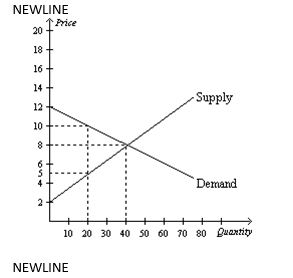Answer the following questions based on the graph that represents J.R.'s demand for ribs per week at Judy's Rib Shack.

a. At the equilibrium price, how many ribs would J.R. be willing to purchase?
b. How much is J.R. willing to pay for 20 ribs?
c. What is the magnitude of J.R.'s consumer surplus at the equilibrium price?
d. At the equilibrium price, how many ribs would Judy be willing to sell?
e. How high must the price of ribs be for Judy to supply 20 ribs to the market?
f. At the equilibrium price, what is the magnitude of total surplus in the market?
g. If the price of ribs rose to $10, what would happen to J.R.'s consumer surplus?
h. If the price of ribs fell to $5, what would happen to Judy's producer surplus?
i. Explain why the graph that is shown verifies the fact that the market equilibrium quantity) maximizes the sum of producer and consumer surplus.
Definitions:
Classical Conditioning
A learning process that pairs a neutral stimulus with an unconditioned stimulus to trigger an involuntary response.
Desensitization
The type of sensory adaptation in which we become less sensitive to constant stimuli. Also called negative adaptation.
Reinforcement Schedules
The strategies implemented in the timing and frequency of reinforcing stimuli following desired behaviors.
Commuter Trains
Trains primarily used for transporting passengers between places of residence and places of work or study.
Q46: All else equal, what happens to consumer
Q62: Refer to Table 7-17. Both the demand
Q182: Economists generally agree that the most important
Q203: At Nick's Bakery, the cost to make
Q228: Refer to Figure 8-10. Suppose the government
Q258: Refer to Table 7-6. If the market
Q368: If the tax on a good is
Q379: Which of the following events always would
Q443: In which of the following cases is
Q446: Refer to Figure 8-7. Before the tax